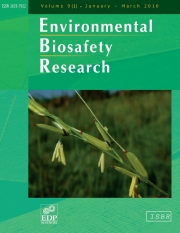Article contents
Transgene escape in sugar beet production fields: data from six years farm scale monitoring
Published online by Cambridge University Press: 16 November 2007
Abstract
Concerns have been raised in Europe about the efficiency, sustainability, and environmental impact of the first genetically modified crops. The committees and regulators in charge of approving procedures have encouraged a field trial approach for safety assessment studies under current agronomic conditions. We describe the gene flow from sugar beet (Beta vulgaris L.) in a multi-year and multi-crop monitoring study on farmers' fields at two locations that has been carried out since 1995. We analyzed two sugar beet lines that have been genetically transformed for herbicide resistance. One sugar beet has resistance to glufosinate and the other to glyphosate. Large differences among lines, years and locations were observed. These differences provided a broad range of situations to estimate the risks. Sugar beet bolters produced the majority (86%) of the herbicide-resistant seeds harvested in the field. Direct pollen flow from sugar beet bolters to weed beets that were growing within the same field as well as in a neighboring field that was left fallow accounted for only 0.4% of the resistant seeds released over the years and locations. Descendants of the hybrids between the sugar beet and the weed beet produced the remaining 13.6% of resistant seeds. Herbicide-resistant seeds from the progeny of the weed beet were recorded up to 112 m away from the closest transgenic pollen donor. Indications were observed of non-randomness of the weed beet producing resistant progeny. We also analyzed pollen flow to male-sterile bait plants located within and outside of the sugar beet field. Herbicide-resistant pollen flow was recorded up to 277 m, and fitted with an inverse power regression. Using sugar beet varieties with no, or very low, sensitivity to bolting and destroying bolters are two necessary measures that could delay gene flow.
Information
- Type
- Research Article
- Information
- Copyright
- © ISBR, EDP Sciences, 2007
References
- 29
- Cited by

